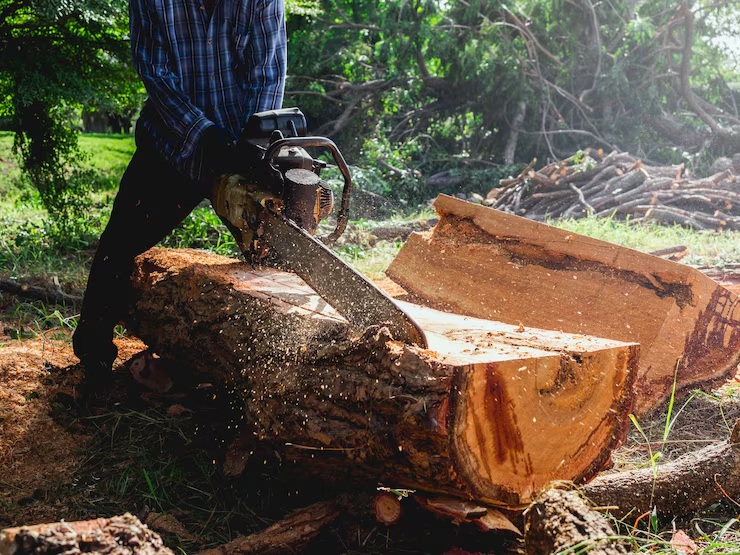Stump Grinding Cost: What to Expect
Tree removal is a necessary process for maintaining the safety, aesthetics, and functionality of your property. However, cutting down a tree often leaves behind an unsightly stump. To restore the look of your yard, stump grinding is the most effective solution. But, how much does stump grinding cost, and what factors influence the price? In this article, we’ll explore the key aspects of stump grinding costs, helping you to understand what to expect when budgeting for this service.
Understanding Stump Grinding
Stump grinding is the process of removing the stump left behind after a tree is cut down by using a machine equipped with a rotating cutting disc. This disc chips away at the wood, grinding it down to below ground level, leaving the area flat and ready for replanting or landscaping. Unlike stump removal, which involves pulling the entire stump and root system out of the ground, stump grinding is less invasive and leaves the roots in place.
Factors That Affect Stump Grinding Cost
The cost of stump grinding can vary depending on several factors. Understanding these factors can help you get a more accurate estimate and make an informed decision.
Size of the Stump
One of the most significant factors affecting stump grinding cost is the size of the stump. The diameter of the stump determines how long it will take to grind down, which directly impacts the cost. Generally, larger stumps require more time and effort to grind, leading to higher costs.
- Small Stumps (Less than 12 inches): These typically cost between $75 and $150 to grind.
- Medium Stumps (12 to 24 inches): Expect to pay between $150 and $300.
- Large Stumps (More than 24 inches): These can cost $300 or more, depending on the size.
- Type of Wood
The type of tree that the stump is made from also affects the grinding cost. Hardwoods like oak, maple, and walnut are denser and more challenging to grind, resulting in higher costs. On the other hand, softwoods like pine or cedar are easier to grind and usually cost less.
Root System
The complexity of the root system plays a role in the overall cost. If the stump has an extensive root system that spreads out far from the base, it will require more time and effort to grind, increasing the cost. Additionally, if the roots are particularly deep, this could also raise the price.
Location of the Stump
The location of the stump on your property can influence the cost of grinding. If the stump is in a hard-to-reach area, such as near a fence, building, or on a slope, it may be more challenging for the equipment to access, increasing labor costs. In contrast, easily accessible stumps in open spaces may cost less to grind.
Condition of the Stump
The condition of the stump, including whether it is fresh, rotting, or infested with pests, can affect the cost. Fresh stumps are usually harder and more challenging to grind, leading to higher costs. However, if the stump is already rotting or decayed, it may be easier and cheaper to grind.
Number of Stumps
If you have multiple stumps to grind, many companies offer discounts for grinding more than one stump at a time. The cost per stump decreases as the number of stumps increases, making it more economical to grind several stumps at once.
Regional Differences
Stump grinding costs can vary based on your geographical location. In regions where the cost of living is higher, you can expect stump grinding services to be more expensive. Additionally, the availability of service providers in your area can also influence pricing.
How Much Should You Expect to Pay?
On average, homeowners can expect to pay between $150 and $450 for stump grinding services, with most people spending around $200. This price usually includes the cost of labor, equipment, and the time required to grind the stump.
Hourly Rates
Some companies charge by the hour rather than per stump. Hourly rates typically range from $100 to $150. This option can be more cost-effective if you have multiple stumps to grind or if the stump is particularly large and difficult to remove.
Per Inch of Diameter
Another common pricing method is charging per inch of the stump’s diameter. Prices range from $2 to $5 per inch, depending on the factors mentioned above. This method is often used for larger stumps.
Minimum Fees
Some stump grinding companies have a minimum fee, usually between $75 and $100, regardless of the size of the stump. This ensures that the company covers the cost of travel and equipment setup, even for smaller jobs.
Additional Costs to Consider
When budgeting for stump grinding, there are a few additional costs you may need to consider.
Cleanup and Removal
After the stump is ground down, you’ll be left with wood chips and debris. Some companies include cleanup and removal in their pricing, while others may charge extra. If you prefer to handle cleanup yourself, you can save money, but it’s essential to check with the service provider beforehand.
Filling and Landscaping
Once the stump is removed, you may want to fill the hole with soil and plant grass or other vegetation. Some companies offer these services for an additional fee. Alternatively, you can handle this yourself to save on costs.
Permit Fees
In some areas, you may need a permit to remove a tree stump, especially if the stump is on public property or near a utility line. Permit fees can vary, so it’s essential to check with your local municipality before proceeding.
DIY Stump Grinding vs. Hiring a Professional
If you’re considering saving money by renting a stump grinder and doing the job yourself, it’s essential to weigh the pros and cons. While renting a stump grinder can be cheaper, it requires time, effort, and some level of expertise to operate the equipment safely. Additionally, DIY stump grinding may not be suitable for large or hard-to-reach stumps.
Hiring a professional ensures the job is done efficiently and safely, with less risk of injury or damage to your property. While it may cost more upfront, the convenience and peace of mind that come with professional services are often worth the investment.
Conclusion
Stump grinding is an essential service for maintaining the appearance and safety of your property after tree removal. While the cost of stump grinding can vary depending on factors such as the size of the stump, the type of wood, and the location, understanding these variables can help you budget appropriately. On average, you can expect to pay between $150 and $450, with additional costs for cleanup, landscaping, and permits. Whether you choose to hire a professional or tackle the job yourself, it’s essential to consider all factors to make an informed decision that meets your needs and budget.
FAQs
How long does stump grinding take?
The time required to grind a stump depends on its size, type of wood, and location. On average, it takes about 15 to 60 minutes to grind a single stump. Larger stumps or those with extensive root systems may take longer.
Is stump grinding environmentally friendly?
Yes, stump grinding is considered environmentally friendly. The process recycles the wood into mulch, which can be used in landscaping. Additionally, it prevents the stump from becoming a breeding ground for pests or diseases.
Can I plant a tree in the same spot after stump grinding?
Yes, you can plant a new tree in the same spot after stump grinding. However, it’s essential to remove as much of the old root system as possible and ensure the soil is well-prepared for the new tree.
Will stump grinding damage my lawn?
Stump grinding is a relatively non-invasive process, but it can leave behind a hole and wood chips. Most companies offer cleanup and lawn restoration services to minimize any impact on your lawn.
What’s the difference between stump grinding and stump removal?
Stump grinding grinds the stump down to below ground level, leaving the roots in place, while stump removal involves pulling the entire stump and root system out of the ground. Stump grinding is less invasive and more cost-effective, while stump removal is more thorough but more expensive and labor-intensive.







